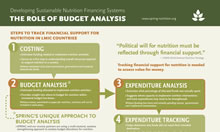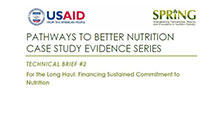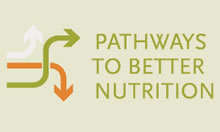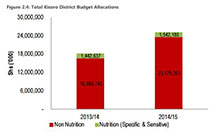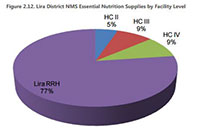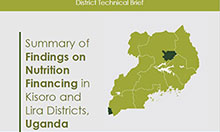The Value of Investing in Nutrition
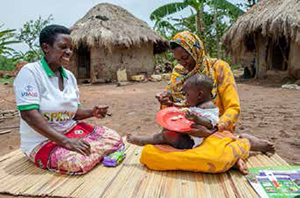
Nutrition is vital for social and economic improvements in Uganda. Hence, critical actions are needed to strengthen policy and financing to improve nutrition.
- 15% of child mortality is caused by malnutrition, and almost 82% of childhood undernutrition cases go untreated by the health care system in Uganda.
- Childhood undernutrition and hunger cost Uganda up to 5.6% of the Gross Domestic Product (GDP) or UGX 1.8 trillion every year.
- Stunted children have a higher risk of grade repetition, costing 19,655 million UGX in 2009 or 1.8% of the total national investment in education.
- Greater dollars (or shillings) for nutrition will turn into gains in healthy and productive life years. Uganda’s Cost of Hunger study found that for every USD $1 spent on nutrition, Uganda can save USD $30 through improved health and economic benefits.
The Current Context
Between 2013 and 2015 the USAID-funded multisectoral SPRING project conducted a rigorous analysis of publicly available data on funding and expenditures for nutrition. The “Pathways to Better Nutrition” study revealed important details about the status of nutrition financing in Uganda.
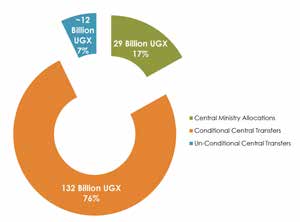
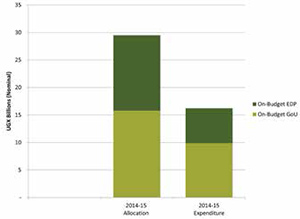
- Funding did not increase over time.
- Despite a growing need for support, onbudget nutrition funding (managed by the Ministry of Finance, Planning and Economic Development.) stayed about the same (27.2 billion UGX in the 2013-2014 budget and 29.5 billion UGX in the 2014-2015 budget).
- Nutrition funding was minimal compared to spending in other areas.
- The government of Uganda spent $9 per child under 5 on nutrition-specific activities.
- Nutrition funding was only 1% of nationallevel government budget (not including transfers to the district).
- Nutrition funding made up 5% of the total development assistance to Uganda from external development partners.
- Most nutrition funding was not provided by the government and was off-budget
- 63% of the funds available for nutrition in 2014-2015 were provided by nongovernment actors and were not included in the government budgets or managed through the treasury.
- The single largest contributions to on-budget nutrition funding were through central transfers.
- However, there is significant confusion in how those funds were spent and how ministries contributed.
- Government funding for nutrition was underspent
- As illustrated in the graphic only around 50% to 60% of allocated government funding was spent each year, due to delayed release of funds or procurement delays. Onbudget spending by external development partners varied greatly from year to year.
- Spending on nutrition at the district level is constrained - Only about 6% to 7% of spending in districts was on nutrition activities since the vast majority of district funds are earmarked at the national level.Spending on nutrition at the district level is constrained - Only about 6% to 7% of spending in districts was on nutrition activities since the vast majority of district funds are earmarked at the national level.
Strengthening the Power of Nutrition Funding in Uganda
There are a number of actions stakeholders can take to improve funding for nutrition:
- Increase opportunities for nutrition staff and budget staff to communicate at the national level, within sectors, and at the district level to improve work planning and budgeting for nutrition.
- Train district officials on why and how to include nutrition in district work plans, institutionalizing the National Nutrition Planning Guidelines for Uganda.
- Reduce restrictions on district funding and improve reporting on the allocation of these funds.
- Include nutrition as a priority in each sector’s investment and development plans, and within each district’s development plans.
- Institutionalize nutrition funding into the Ugandan budget to allow for more consistent and transparent funding from year to year by-
- including the new nutrition planning guidelines in the budget-call circulars each year
- naming nutrition as a budget line
- applying tracking codes across sectors
- setting targets for the percentage of a sector’s yearly budget that should go toward nutrition.
- Approve and implement the Uganda Nutrition Action Plan (UNAP) monitoring and evaluation framework, which includes nutrition-specific and sensitive indicators, o be able to track and compare progress.
References
Namugumya, B., Sethuraman, K., Elisabeth, A., Oot, L., Kovach, T., & Musiimenta, B. (2014). Reducing Malnutrition in Uganda: Estimates to Support Nutrition Advocacy - Uganda PROFILES 2013. Washington DC and Kampala: FHI360/FANTA and Office of the Prime Minister of Uganda.
Office of the Prime Minister, and FANTA Project. 2014. Economic Development and Nutrition Fact Sheet. Malnutrition in Uganda: We’ve Already Paid Too High a Price. Kampala, Uganda: Office of the Prime Minister, USAID FANTA Project.
WFP, UNECA, & AUC. (2013). The cost of hunger in Uganda: implications on national development and prosperity. Kampala: World Food Programme, United Nations Economic Commission for Africa and the African Union Commission.
Pomeroy-Stevens, Amanda, Nancy Adero, Alexis D’Agostino, Hannah Foehringer Merchant, Abel Muzoora, Daniel Lukwago, Diana Tibesigwa, Edgar Agaba, Lidan Du, and Ezekiel Mupere. 2016. Pathways to Better Nutrition in Uganda: Final Report. Arlington, VA: Strengthening Partnerships, Results, and Innovations in Nutrition Globally (SPRING) project.
